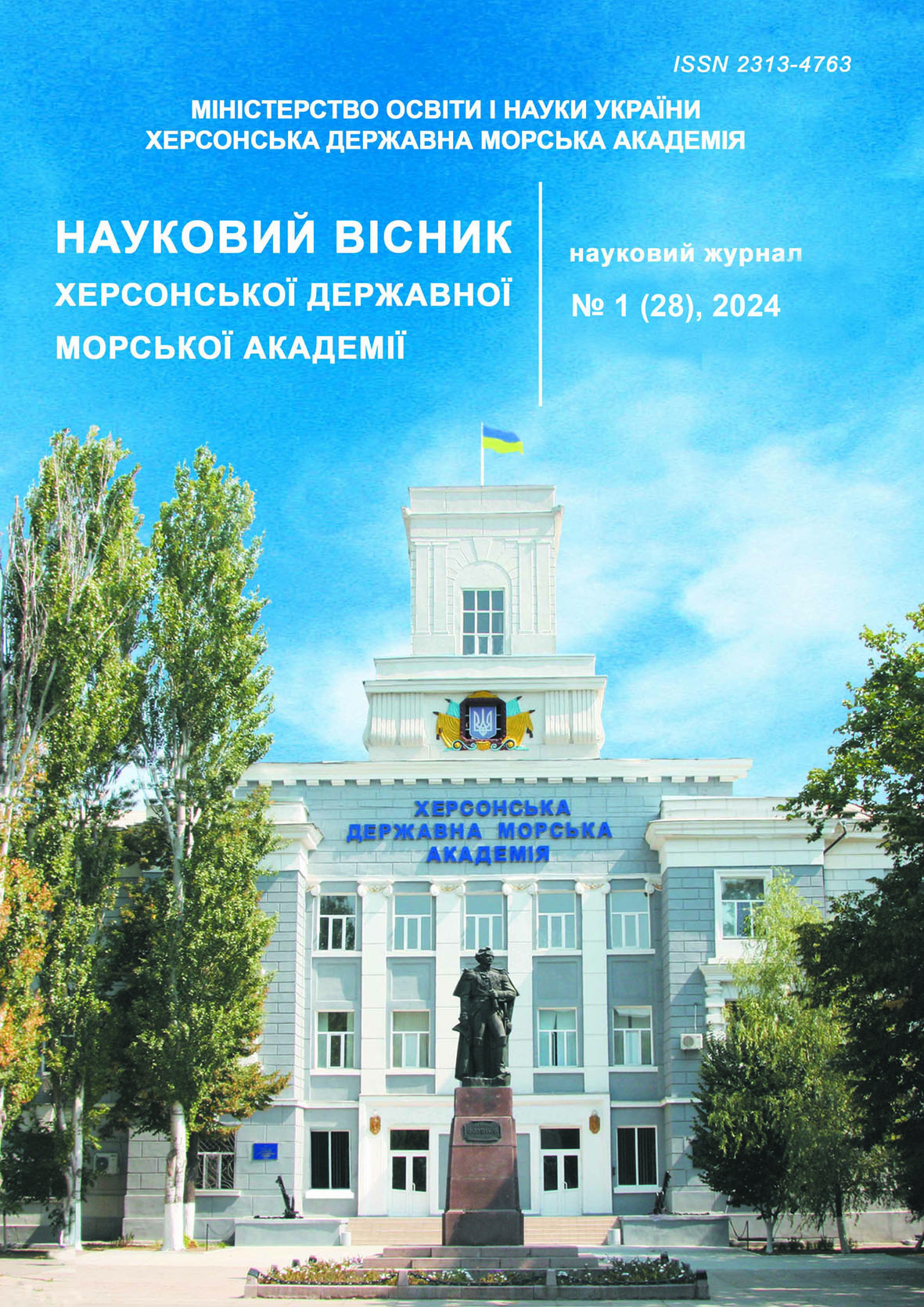ВИКОРИСТАННЯ НАДЛИШКОВОГО КЕРУВАННЯ ДЛЯ МІНІМІЗАЦІЇ ЕНЕРГОСПОЖИВАННЯ
https://doi.org/10.33815/2313-4763.2024.1.28.163-173
Анотація
Питання зменшення енергоспоживання на суднах, а також пов’язані з цим питання скорочення викидів та покращення стану навколишнього середовища є особливо актуальними. Шляхи вирішення цих питань різні, але найчастіше використовуються конструктивні рішення, гідродинамічні рішення, вітрила або сучасні силові установки. Зменшення енергоспоживання також можна досягти за рахунок правильного планування маршруту, психологічної підготовки екіпажу, автоматизації процесів керування рухом. У статті запропоновано метод мінімізації енергоспоживання за рахунок використання надлишкового керування. Надлишкові структури виконавчих пристроїв широко використовуються на сучасних суднах, зокрема, на суднах з динамічною системою позиціонування. Традиційне призначення надлишкових структур – збільшення надійності системи керування по виконавчим пристроям та підвищення маневрових можливостей судна. Запропонований метод використовує наявні на суднах надлишкові структури ще й для мінімізації витрат палива. Отриманий результат пояснюється знаходженням оптимальних керувань, що мінімізують енергоспоживання, шляхом вирішення в бортовому обчислювачі автоматизованої системи оптимізаційної задачі з лінійними та нелінійними обмеженнями на параметри керування, використанням знайдених оптимальних керувань для виконання операцій. Працездатність та ефективність розробленого методу підтверджена математичним моделюванням у середовищі MATLAB. Результати проведеного експерименту показали, що використання розробленого методу дозволяє знизити енерговитрати на (35–50)%. При цьому, додаткове навантаження на розрахунковий такт бортового обчислювача не перевищує 25–50 мс, що становить (2,5–5)% всього навантаження.
Посилання
2. Kai, L., Yanyun, Y., Yunlong, W., Zhenwu, H. (2018). Research on structural optimization method of FRP fishing vessel based on artificial bee colony algorithm, Advances in Engineering Software, 250–261. doi: 10.1016/j.advengsoft.2018.03.011.
3. Feng, Y., Chen, Z., Dai, Yi, Wang, F., Cai, J., Shen, Z. (2018). Multidisciplinary optimization of an offshore aquaculture vessel hull form based on the support vector regression surrogate model, Ocean Engineering, 145–158. doi: 10.1016/j.oceaneng.2018.07.062.
4. Ma, Y., Bi, H., Hu, M., Zheng, Y., Gan, L. (2019). Hard sail optimization and energy efficiency enhancement for sail-assisted vessel, Ocean Engineering, 687–699. doi: 10.1016/j.oceaneng.2019.01.026.
5. Zinchenko, S., Tovstokoryi, O., Sapronov, O., Petrovskyi, A., Ivanov, A., Tymofeiev, K. (2022). Development of automatic control methods of vessel rotation around the pivot point without drift, Technology Audit and Production Reserves, 6(2(68), 16–21. https://doi.org/10.15587/2706-5448.2022.269364.
6. Zinchenko, S. M., Mamenko, P. P., Grosheva, O. O., Mateichuk, V. M. (2019). Automatic control of the vessel’s movement under external conditions, Naukovyi Visnyk KSMA, №2(21), s. 10–15. DOI: 10.33815/2313-4763.2019.2.21.010-015. http://journals.ksma.ks.ua/nvksma/ article/view/ 480/416.
7. Moiseenko, V. S., Zinchenko, S. M., Tovstokoryi, O. M. (2020). Automatic beam control of laser–optical position reference system, Materials of the II International Scientific and Practical Maritime Conference of the Department of Power Plants and TE of Odessa National Maritime University MPP & O-2020, April 2020, Odessa-Istambul-Odessa. https://drive. google.com/file/d/1HEX2RVuA1KV5JjMfQcqYZ1f4SCFMcy6a/view.
8. Zinchenko, S., Tovstokoryi, O. (2020). What is the pivot point and how to use it to control the vessel, Materials of the XII International Scientific and Practical Conference "Advanced Information and Innovative Technologies for Transport (MINTТ – 2020), May 27–29, 2020, Kherson
9. Luo, M., Shin, S. (2019). Half-century research developments in maritime accidents: Future directions, Accident Analysis & Prevention, 448–460. doi: 10.1016/j.aap.2016.04.010.
10. Jacobellis, G., Gandhi, F., Floros, M. (2019). Using Control Redundancy for Power and Vibration Reduction on a Coaxial Rotor Helicopter at High Speeds, Journal of the american helicopter society. doi: 10.4050/JAHS.64.032008.
11. Gao, W., Tang, Q., Yao, J., Yang, Y. (2020). Automatic motion planning for complex welding problems by considering angular redundancy, Robotics and Computer-Integrated Manufacturing, doi: 10.1016/j.rcim.2019.101862.
12. Pakaste, R., Laukia, K., Wilhelmson, M., Kuuskoski, J. (1999) Experience with Azipod®propulsion systems on board marine vessels, Marine Propulsion. https://library. e.abb.com/public/2314773146eb2d77c1256ec300341511/12-18%20ENG%209902.pdf.
13. IMCA Marine Division: Guidelines for the design and operation of dynamically positioned vessels. (2019). The International Marine Contractors Association. https://www.imca-int.com/product/guidelines-for-the-design-and-operation-of-dynamically-positioned-vessels/.
14. Cheng, X., Deng, S., Cheng, B., Meiqian, L., Zhou, R. (2020). Optimization of bias current coefficient in the fault-tolerance of active magnetic bearings based on the redundant structure parameters, Automatika, 602–613. doi: 10.1080/00051144.2020.1806012.
15. Santos, M. F., Santos Neto, A. F., Honorio, L., Silva, M. F., Mercorelli, P. (2023). Robust and Optimal Control Designed for Autonomous Surface Vessel Prototypes, IEEE Access, (99):1–1. doi: 10.1109/ACCESS.2023.3239591.
16. Rigatos, G. A. (2022). Nonlinear optimal control approach for underactuated offshore cranes, Ships and Offshore Structures. doi: 10.1080/17445302.2022.2150420.
17. Bao, X., Jiang, C. (2023). Time-Optimal Control Algorithm of Aircraft Maneuver, in book: Advances in Guidance, Navigation and Control, Proceedings of 2022 International Conference on Guidance, Navigation and Control. DOI: 10.1007/978-981-19-6613-2_454.
18. Bartels, S., Helling, S., Meurer, T. (2023). Inequality Constrained Optimal Control for Rope-Assisted ASV Docking Maneuvers, IFAC-PapersOnLine, pp. 44–49. doi: 10.1016/j.ifacol.2022.10.407.
19. Leparoux, C., Herisse, B., Jean, F. (2022). Structure of optimal control for planetary landing with control and state constraints, ESAIM Control Optimisation and Calculus of Variations. doi: 10.1051/cocv/2022065.
20. Huang, W., Xu, H., Wang, J., Miao, C., Ren, Y., Wang, L. (2020). Redundancy Management for Fault-tolerant Control System of an Unmanned Underwater Vehicle, 5th International Conference on Automation, Control and Robotics Engineering (CACRE): Proceedings, China, 19–20 Sept. 2020. doi: 10.1109/CACRE50138.2020.9230038.
21. Li, W., Shi, G. (2020). Redundancy management strategy for electro-hydraulic actuators based on intelligent algorithms, Advances in Mechanical Engineering. doi: 10.1177/ 1687814020930455.
22. Piloting Vessels Fitted with Azimuthing Control Devices (ACD’s). (2013). United Kingdom Maritime Pilot’s Association (UKMPA), Transport House, London. https://www.yumpu.com/en/document/view/13677403/piloting-vessels-fitted-with-azimuthing-control-devices-acds.
23. Navi – Trainer 5000. Transas offshore simulator. Instructor manual. (2012). Transas MIP Ltd. https://cyberonboard.com/wp-content/uploads/NT_5000_5_35_Instructor_Manual_eng.pdf.






